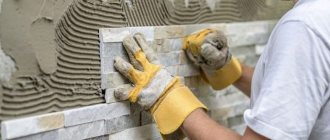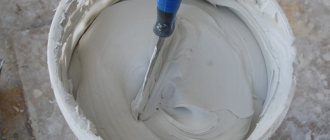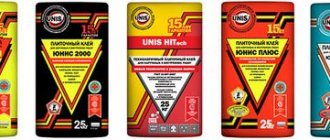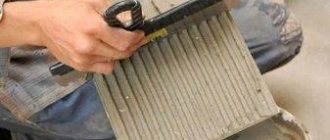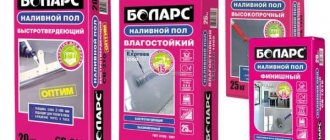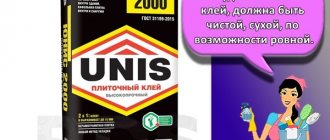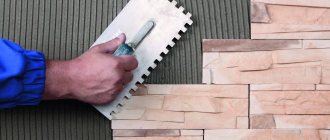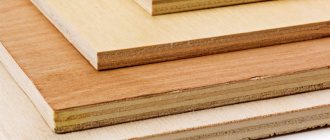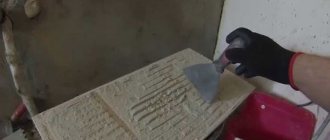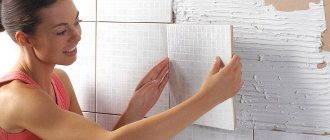Why is gypsum added to cement?
The main purpose of adding gypsum to cement is to slow down the hydration process of the cement after it is mixed with water. The process of cement hydration is that when water is added to cement, it begins to react with C3A and hardens.
Interesting materials:
How high should the bed be? How much laminate stock is needed when laying diagonally? What sign is 1997? Which zodiac sign is the luckiest? What is the procedure for calculating VAT when importing goods? What are the basic principles of accounting? What are the main responsibilities of a contract service? What clarity should I set on my TV? What date should I put in line 100 6 personal income tax? What kind of porridge can you eat for breakfast?
How to use cement adhesive in construction work
Every owner wants to make quality repairs in their home. For this purpose, good finishing materials are purchased, and the layout is carefully thought out. But it is equally important to choose the right mixtures for cladding. For example, when laying tiles, it is important to choose the right adhesive solution. Today there are a lot of them in construction stores. Which foundation is better? Masters say that if you don’t know what to choose, buy glue made from cement mortar. Are these the rules? How to properly use a cement mixture with glue for interior and exterior work? More on this and much more below.
Main varieties
Cement-based adhesive can be used for laying tiles, porcelain stoneware, natural stone and ceramics, for example, Litofloor K66, as well as for other types of finishing and construction work. So, the following types of cement adhesive mortar are distinguished.
- universal, can be used for gluing not only the above materials, but also for fixing mineral wool, foam plastic, sound insulation, drywall on concrete, brick surfaces and plaster;
- for natural stone, can be used in outdoor work;
- frost-resistant, can withstand temperatures down to -10°C under the right operating conditions;
- two-component, can be used for gluing all types of tiles both indoors and outdoors;
- white, can be used for fixing ceramic, stone tiles and mosaics in rooms where there is high humidity;
- elastic, mainly used on surfaces that are subject to deformation due to humidity, can be used in swimming pools, showers, when installing “warm floors”, on terraces and balconies.
Benefits of the mixture
Cement polymer tile adhesive is practically free of disadvantages. Its main advantages include:
- low cost in comparison with other similar compounds;
- ease of preparation and application;
- speed of setting;
- ease of removal of unnecessary residues;
- high adhesion to the surface;
- plastic;
- resistance to mechanical damage after drying;
- resistance to excessive humidity;
- resistance to constant temperature changes;
- safety.
Now it’s clear why cement tile adhesive (see photo) is so popular. Let's now consider how to use it correctly so that the finish lasts for a long time and does not need to be re-laid.
Cooking features
You can actually make cement tile adhesive yourself using PVA. To do this, it is enough to mix cement, fractional sand, PVA and plasticizers in certain proportions. But such a polymer solution with PVA is not always reliable. It is best to trust the professionals and use ready-made cement-based mixtures in your work. To prepare a composition, for example, Litofloor K66, you need:
- pour about 6 liters of water into a container with a volume of 20-30 liters;
- pour the entire bag of cement powder (25 kg) into it;
- using a drill with a special attachment, mix the resulting mixture until a homogeneous consistency is obtained;
- leave the mixture at room temperature for about 10 minutes.
Recipe for making tile adhesive
The presence of cement and sand does not raise any questions; the plasticizer, in turn, should give the solution the necessary elasticity. The plasticizer also adds the necessary frost and water resistance to the glue. Similar properties are useful when tiling a swimming pool or bathroom.
The composition of store-bought glue, without details of the chemical composition, includes
- Cement;
- Necessary additives (minerals and polymers);
- Sand;
- Plasticizer.
Despite the fact that the plasticizer is usually included in the mixture, it is possible to buy it separately. A separately purchased plasticizer is used instead of water, or it can be mixed with water in a ratio of 50% to 50%. The resulting consistency has enhanced properties compared to a mixture prepared entirely with water.
Sand in the glue recipe is used dry. It must be sifted so that there are no lumps.
Only river sand is used in the mixtures. Some manufacturers make their product based on slaked lime. Slaked lime also functions as a plasticizer. As a general rule, cement used in mixtures is grade M-400. Such cement can withstand a load of 400 kg/cm 2 surface area. When preparing tile adhesive yourself, it is better to use cement M-500 or M-600.
Cons of adding PVA
Despite the many benefits that adding PVA provides, this practice also has disadvantages:
Limitations in use (high polymerization rate).
PVA additives in concrete can reach 20%, while modern plasticizing additives work no less effectively, but do not require high concentrations.
Expert advice and recommendations:
Check the expiration date of the glue.
Before starting work, stir the PVA.
Do not work with PVA at ambient temperatures below +10°C.
Make sure to use PVA-MB or PVA dispersion.
Observe the proportions of addition
The addition of PVA to cement mortars increases their plasticity, workability and adhesive properties, and gives the hardened mortar increased density and compressive, tensile and bending strength, and increased abrasion resistance. But adding PVA to concrete is not always advisable. Fortunately, there are modern plasticizing additives for concrete. They have proven effectiveness, are economical and easy to use.
How to make your own dry mixture
If circumstances are such that there is no possibility of purchasing a ready-made adhesive mixture, then it is quite possible to prepare it yourself. To do this, you need to have Portland cement and fine sand available; if the latter comes in lumps, then they should be broken and the sand sifted through a sieve.
In addition to these two components, to add strength to the mixture, you can add PVA or silicate glue to it. You can find out how to make PVA glue at home and how long it takes for PVA glue to dry from our reviews.
The composition of the dry mixture should be the proportion: one share of cement to five shares of sand.
- Next, you should pour water into a previously prepared and cleaned container.
- Gradually add the dry mixture to the water, stirring constantly.
- Also at this moment you can add glue to the prepared solution.
Further actions are identical to those performed when preparing a solution using factory mixtures. After the solution has turned out to be a homogeneous mass without lumps, it needs to be allowed to brew and then mixed again. After this, the resulting solution is ready for use.
Minimum and maximum values
With the correct layer thickness, good adhesion of the adhesive mixture to the base occurs. Insufficient and excessive volume of the mixture leads to a number of problems when facing: the layer may not dry well, crack or delaminate. It happens that after some time the facing material completely moves away from the base.
The maximum thickness of the adhesive when finishing the floor is 1.5 cm. It is recommended to apply no more than 1 cm to the walls. A thicker application can lead to an unpredictable result and defects over the entire area of the cladding.
The maximum cannot be exceeded due to a decrease in the degree of adhesion of the solution. This is due to the increase in his weight. With a large layer thickness, severe shrinkage occurs. Because of this, the tile may burst.
The minimum adhesive layer for small tiles is about 1.5-2 mm, and for large-format tiles - 4-5 mm. It is not recommended to apply a smaller volume of solution, because there will be no adhesion of the tiles to the base.
The calculation of the required amount of composition should be made based on its layer. To do this, the consumption per 1 mm is multiplied by the thickness of the solution. And all the necessary information on applying the glue can be found on its packaging.
How to carry out external cladding in the cold season?
At temperatures below +5°C, cement hydration practically does not occur; ordinary tile adhesive freezes and does not adhere to the tiles. After the onset of a thaw, the tiles peel off.
Common challenges you may encounter
Didn't have time to finish the cladding
Sometimes some façade work cannot be completed during the warm period. Postponing them to spring is impossible for various reasons. Completion of begun facade work during the onset of frost requires the installation of a thermal circuit or heating with heat guns. The cost of work per square meter increases significantly.
The cladding is peeling off
When the weather gets warmer, the cladding, glued in the cold using conventional cement adhesives, peels off and comes off due to temperature changes.
Using the wrong materials in the cold
If you add salt to regular tile adhesive to protect against freezing, then at the end of the work, irremovable efflorescence will appear on the facade. Conventional mixtures in the cold have little plasticity, are difficult to apply and cannot be adjusted. Mixtures without frost-resistant additives in the cold have to be applied in a thicker layer than at normal temperatures. Therefore, glue consumption increases in the cold.
Solution
For external tiling work in the cold season, weber.vetonit ultra fix winter adhesive should be used. Work can be carried out at temperatures down to -10 ° C. Before use, the dry mixture, facing materials and base must have a temperature above 0 °C, the water for preparing the solution must be 7–20 °C. Do not use hot water (t≥35 °C)
Make sure that the base is not icy, frosted or covered with snow. Clean it from dust, dirt, old paint or plaster. Do not carry out work in strong wind, snow or rain.
Preparing the necessary materials
When planning to prepare tile adhesive, you need to adhere to some basic rules.
- All ingredients included in the tile adhesive must be at room temperature;
- Moreover, if the glue is prepared in cold conditions, the liquid and composition must also have a low temperature;
- It is important to use only clean and thoroughly washed tools during work;
- When stirring the solution, you should use only clean water, preferably drinking water, since industrial water may contain undesirable impurities that interfere with the adhesive functions of the solution;
- For safety, you need to wear rubber gloves and a dust mask.
The best brands
The construction market offers products from many domestic and foreign manufacturers. According to reviews, concrete adhesive, which is considered one of the best, is produced by Ceresit.
Domestic brands are no less popular:
- "Leader";
- "Polymen";
- "Polyrem."
Demanded products from foreign manufacturers:
- Bostik;
- Findley;
- seder;
- Emfi;
- Knauf;
- Jovi.
Advice! The leading position as a mixture used for cellular concrete is occupied by the Monolith brand.
When walking or driving, there is a load on the paving stones. If the coating is very hard, then under intense loads the material will quickly become unusable. The elasticity of the composition will create a shock-absorbing cushion and will transfer the load to the concrete base, maintaining the integrity of the tile product.
